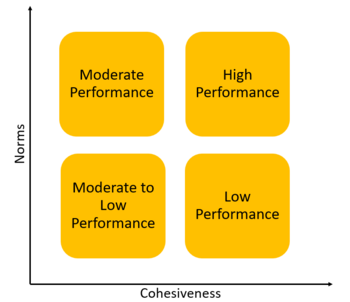Team Cohesiveness
(→Meaning and Importance of Cohesion) |
(→A Practical Method to Achieve Cohesion) |
||
| Line 22: | Line 22: | ||
== A Practical Method to Achieve Cohesion == | == A Practical Method to Achieve Cohesion == | ||
| + | Leadership styles are to be taken into consideration by team leaders trying to promote cohesion in a team. “Supportive leadership” has a positive effect on team cohesion regardless of the cultural context, while “directive behaviour” has a negative effect, especially in individualistic cultures. | ||
| + | |||
== Cohesiveness is just One Aspect == | == Cohesiveness is just One Aspect == | ||
== Annotated bibliography == | == Annotated bibliography == | ||
== References == | == References == | ||
Revision as of 15:17, 13 March 2022
Humans are able to accomplish great projects by forming heterogeneous and complementary teams in terms of skills, knowledge and behavioural competencies. Studies agree cohesiveness is an important characteristic of high-performing teams and underline the existing positive correlation between cohesion and performance, especially when it comes to project management teams.
Cohesiveness is the strength and extent of bonds between members of a same team. It determines the motivation of team-mates to remain in the team and achieve the common goal. Due to its worthiness, it is of great relevance for leaders and project managers to understand how to create and promote cohesion in their teams. Cohesiveness is multidimensional, therefore needs time to be developed and it is more likely to occur in small size teams.
Although team cohesiveness is a crucial aspect in teams that reach high performances, it would be a mistake for team leaders to focus only on a single aspect. A number of other factors equally important contribute to the performance of a team.
Contents |
Meaning and Importance of Cohesion
Nowadays project teams are largely employed in many different industries, in change management projects within organisations and in education as well. The major advantages of teams are the diversity in knowledge and ideas and, if the team is in good sync, the ability to be more effective and efficient than a single person. Psychological aspects have been identified as key elements of project success and efficacy, in particular, it exists a positive correlation between team cohesion and team performance. Cohesion fosters motivation among team-mates and allows coordination.
According to the Merriam-Webster dictionary, cohesion is “the act or state of sticking together tightly”.
At first, team cohesion researchers presented cohesion as a unidimensional characteristic of high-performing teams referring to it as “a field of forces making group members stay together”. The unidimensional description was too vague to convert it in a measurable characteristic, therefore a new multidimensional description was adopted. The most common one is tridimensional and includes:
• “Social cohesion” that refers to interpersonal attraction between team-mates, interest in other’s company, time spent together and friendship or closeness;
• “Task cohesion” that reflects the shared commitment of a team to a certain task or goal and the motivation to coordinate team efforts to achieve goals;
• “Group pride”, a dimension studied mostly in sport teams.
Since it takes time to create meaningful bonds, one of the most relevant factors that influences cohesion is the time spent together.
A Practical Method to Achieve Cohesion
Leadership styles are to be taken into consideration by team leaders trying to promote cohesion in a team. “Supportive leadership” has a positive effect on team cohesion regardless of the cultural context, while “directive behaviour” has a negative effect, especially in individualistic cultures.
